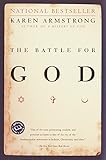
The Battle for God: A History of Fundamentalism (Ballantine Reader's Circle)
- 作者: Karen Armstrong
- 出版社/メーカー: Ballantine Books
- 発売日: 2001/01/30
- メディア: ペーパーバック
- クリック: 43回
- この商品を含むブログ (28件) を見る
先ずヒロシマ/ナガサキの原爆を巡って;
ホロコースト*2を巡って;
For decades, men and women had dreamed of a final apocalypse wrought by God; now, it appeared, human beings no longer needed a supernatural deity to end the world. They had used their prodigious skill and learning to find the means of doing this efficiently for themselves. As they contemplated these new facts of life, people became aware as never before of the limitations of the rationalist ethos. Faced with catastrophe on such q scale, reason is silent; that is—literally—nothing that can say.(p.200)
今引用した前半部はジグムント・バウマンに、後半部の「地獄」のイメージの話はジョージ・スタイナーに依拠している。
The Holocaust would become an icon of evil for n times. It was a by-product of modernity, which, from the very beginning, had often involved acts of ethnic cleansing*3. The Nazis used many of the .tools and achievements of the industrial age to deadly effect. The death camps were a fearful parody of the factory, right down to the industrial chimney itself, and efficient bureaucracy and management. The Holocaust was an example of scientific and rational planning, in which everything is subordinated to a single, limited, and clearly defined objective. Born of modern scientific racism, the Holocaust was the ultimate in social engineering in what has been called the “garden” culture of the twentieth century. Science itself was also deeply implicated in the death camps and the eugenic experiments carried out there. At the very least, the Holocaust showed that a secularist ideology could be just as lethal as any religious crusade.
The Holocaust was also a reminder of the danger that can accrue from the death of God in human consciousness. In Christian theology hell had been defined as the absence of God. The camps seemed an uncannily accurate reproduction of the imagery of the inferno, which had haunted Europeans for centuries. The flaying, racking, whipping, screaming, and mocking, the deformed, distorted bodies, the flames, and the stinking air all recalled the Christian hell depicted by the poets, painters, sculptors, and dramatists of Europe. Auschwitz was a dark epiphany, giving human beings a glimpse of what life could be like once all sense of sacredness has been lost. At its best (and only at its best), religion had helped people to cultivate an appreciation of the holiness of humanity in its myths, rituals, and cultic and ethical practices. By the mid-twentieth century, it seemed that an unfettered rationalism could feel impelled to create a hell upon earth, an objective correlative of God’s absence. There was a nihilistic impulse that could draw human beings who had more power than they had ever had before to expend enormous creativity in mass destruction. (…) (pp.200-201)
The death camp and the mushroom cloud are icons that we contemplate and take to heart so that we do not become chauvinistic about the modern scientific culture that so many of us in the developed world enjoy. But these icons can also give us an insight into the way some religious people regard modern secular society, in which they also experience the absence of God. Some fundamentalists see modernity as equally hubristic, evil, and demonic; their visions of modern city or the secular ideology fills them with something of the same dread and helpless rage as overtakes the liberal secularists who gaze into the darkness of Auschwitz. (…) (p.201)
*1:See http://d.hatena.ne.jp/sumita-m/20070922/1190487945
*2:See also http://d.hatena.ne.jp/sumita-m/20080104/1199468688 http://d.hatena.ne.jp/sumita-m/20080224/1203875355 http://d.hatena.ne.jp/sumita-m/20080605/1212640212 http://d.hatena.ne.jp/sumita-m/20080822/1219374573
*3:See eg. http://d.hatena.ne.jp/sumita-m/20070930/1191125598